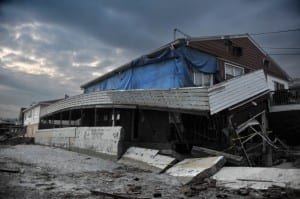Hurricane Sandy obliterated many records along the East Coast, from its extraordinarily low air pressure to the storm surge. In some ways it was even worse than a worst-case scenario.
Here is a roundup of some of the staggering statistics.
 Air Pressure Records:
Air Pressure Records:
– Sandy had a minimum central pressure of 946 mb when it made landfall, which was the second-lowest pressure of any storm to come ashore north of Cape Hatteras, N.C. Only the Hurricane of 1938 had a lower air pressure reading at landfall that far north, which was 941 mb. In general, the lower the air pressure, the stronger the storm.
– Atlantic City, Baltimore, Philadelphia, and Trenton, N.J., all set records for the lowest air pressure reading ever recorded. At Atlantic City, which was close to the storm’s landfall location, the pressure fell to 945.6 mb, smashing the record of 961 mb, set in 1932. In Philadelphia, the pressure dropped to 953 mb, which broke the old record of 963 mb set during the “Superstorm of 1993.”
What’s noteworthy about these air pressure records is that they show that the storm was even more intense than aworst-case scenario studied by MIT’s Kerry Emanuel and Princeton’s Michael Oppenheimer. They published a study in June that warned of New York City’s vulnerability to storm surge flooding, but the storm they modeled had a minimum central pressure of about 960 mb at landfall. In other words, their worst-case scenario storm wasn’t as intense as Hurricane Sandy turned out to be.
Storm Surge
As expected, the extremely powerful storm surge proved to be Hurricane Sandy’s fiercest weapon, as water overwhelmed defenses throughout coastal New Jersey, New York City, Connecticut, and Rhode Island.
Here are some of Sandy’s most significant storm surges – measured as feet above the average low tide:
14.38 feet – Kings Point, N.Y.
13.88 feet – The Battery, Lower Manhattan, which included a storm surge component of 9.23 feet. (Put another way, the water level at The Battery rose to 9.15 feet above the average high-tide line.)
13.31 feet – Sandy Hook, N.J. (Put another way, the water level at Sandy Hook rose to 8.1 feet above the average high-tide line.)
The storm surge at The Battery broke the old record, which was recorded during Hurricane Donna in 1960. It also broke the record of 11.2 ft. from a powerful hurricane that struck the region in 1821. Note that the Sandy Hook gauge stopped recording at 13.31 feet, so the actual highest water level was very likely higher than that.
Winds:
High winds affected the entire eastern third of the country, creating whitecaps on the surface of Lake Michigan at the same time that the Atlantic Ocean was still inundating coastal communities in the Mid-Atlantic states. Here are some of the strongest gusts:
90 mph – Islip, N.Y.
90 mph – Tompkinsville, N.J.
86 mph – Westerly, R.I.
83 mph – Cuttyhunk, Mass.
81 mph – Allentown, Pa.
80 mph – Newark, N.J.
79 mph – JFK Airport, N.Y.
Rain and Snow:
Unlike Hurricane Irene in 2011, Sandy did not produce devastating inland flooding, in part because it dropped less rain, and also because the Northeast and Mid-Atlantic had been quite dry leading up to the event. Still, there were some formidable rainfall totals, such as 12.55 inches in Easton, Md., and 11.91 inches in Wildwood, NJ.
One of the most unusual aspects of this enormous storm was the crippling amount of heavy, wet snow it produced in the higher elevations of Maryland, Pennsylvania, Tennessee, Virginia, West Virginia. Snow also fell in parts of Ohio. During a media conference call as Sandy was nearing landfall, Louis Uccellini, a leading expert on snowstorms and the director of the National Center for Environmental Prediction in College Park, Md., said he knows of no previous hurricane that also dropped such heavy snow.
Here are some of the highest snow totals:
34.0 in. – Gatlinburg, Tenn.
33.0 in. – Clayton, W. Va.
29.0 in. – Redhouse, Md.
24.0 in. – Norton, Va.

here are several components necessary to protecting a company’s physical and data infrastructures, and some of these aspects may vary by country. For example, companies located in the United States have several insurance options for shielding and repairing their physical building and assets except the Bexley disaster recovery plan. While there are different types of coverage and the requirements and riders may vary by state, companies have several options for protecting themselves.